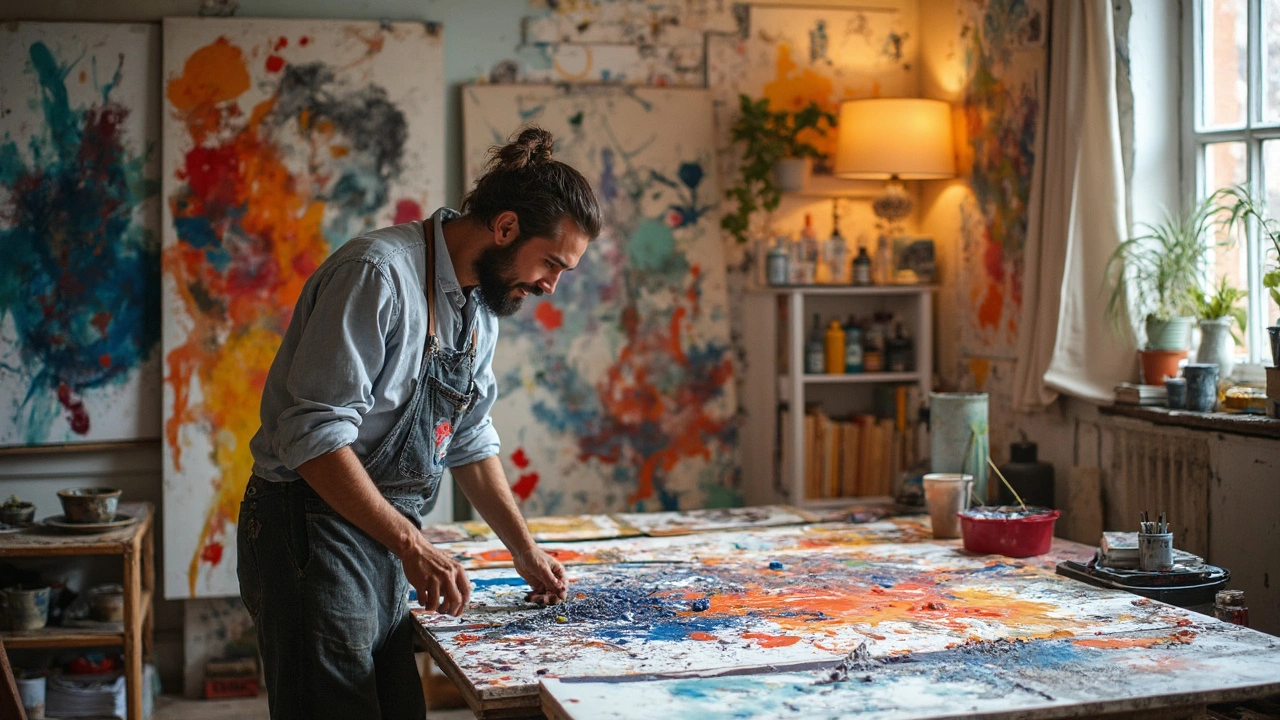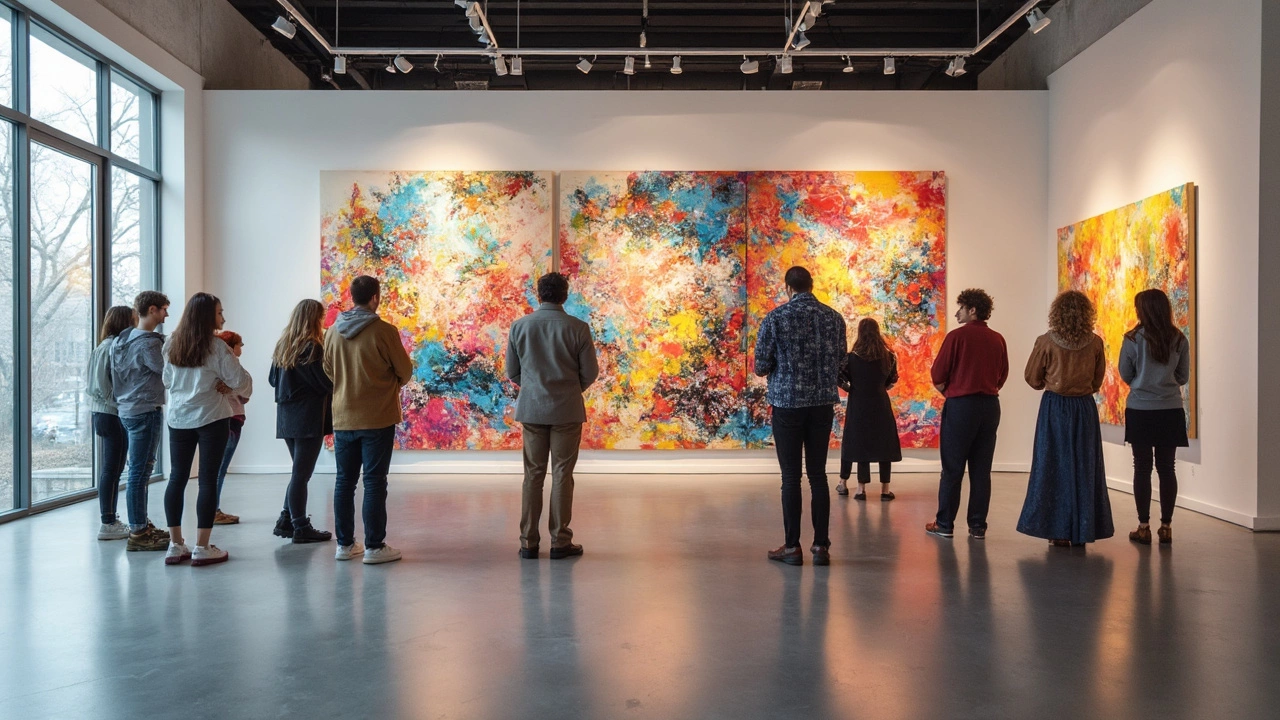Ever stare at a painting and think, Is this supposed to be something? If the answer is no, you might be looking at abstract art. This style tosses out the rules about painting things to look 'real.' Instead, it goes straight for feelings, ideas, and colors that grab you in ways you might not expect.
Abstract art isn’t a puzzle you’re supposed to solve. It works like music—sometimes there isn’t a story or a clear image, but you just feel something. The most important thing is that it’s about breaking away from what’s obvious. For artists, it means there are no limits. For viewers, it’s an open invitation to bring your own meaning to the piece.
If you’re tired of standing in front of a canvas and wondering what you’re missing, stick around. You’ll learn what really makes abstract art tick, why artists love it, and how you can actually enjoy it—even if all you see is a bunch of shapes and lines at first glance.
- What Is Abstract Art Really About?
- How Do Artists Unlock the Meaning?
- Famous Abstract Artists Who Broke the Mold
- Making Sense of Abstract Art: Tips for Viewers
What Is Abstract Art Really About?
Abstract art is all about skipping the stuff you can easily recognize, like trees, people, or landscapes. Artists working in this style ditch the usual rules about making things look realistic. Instead, they play with shapes, colors, and lines to get ideas and feelings across. Sometimes, the messier or weirder it looks, the more freedom there is.
The roots of abstract art go back to the early 1900s. Artists like Wassily Kandinsky, considered the first true abstract painter, started using color and form to express emotion instead of just copying the world outside. Kandinsky thought painting should be like music—it doesn’t need words or pictures to make you feel something.
What trips most people up is that there’s no right answer to what you’re seeing. Abstract art invites you to react however you want. Some folks love how open it is, while others find it confusing. That’s normal. The goal isn’t to find a secret meaning, but to notice what kind of reaction or thought it sparks in you.
Here’s what makes abstract art different from other art:
- No need to recognize anything—sometimes it’s just color and line.
- The focus is on emotion, movement, or an idea, not objects or people.
- There are no rules—every artist can invent their own way to show what’s in their head.
- It relies on a visual language, not on pictures of real things.
So, if you’ve ever felt lost looking at abstract art, don’t worry. It’s truly about the feeling, not the facts. Once you stop trying to "get" it, you might actually start to enjoy it.
How Do Artists Unlock the Meaning?
Abstract artists don’t just toss colors on a canvas and hope for the best. There’s usually a plan, even if it’s a loose one. They use things like colors, shapes, and texture as a visual language. Each choice is on purpose—even if it looks wild or random. For example, Wassily Kandinsky once compared painting with strong colors to writing powerful music. He believed every color had its own mood and could stir up feelings without showing a single recognizable thing.
One of the main ways artists unlock meaning is through color. Reds might spark excitement or even anger, while blues can bring calm. They mix these in ways that get a reaction. Mark Rothko, for instance, stacked big blocks of color to make viewers feel things like awe or anxiety just from standing in front of his paintings.
Artists also play with form and movement. Think of Jackson Pollock splashing paint all over the place—he wasn’t just making a mess. Each swirl and drip was about energy and letting go, showing viewers something about chaos or freedom. Texture plays a role too; some artists use thick paint or scrape into the surface, adding physical depth you can actually feel if you were allowed to touch it.
Here’s how artists tap into meaning with abstract art:
- Color choices: Every color says something, whether loud or quiet.
- Forms and lines: These guide your eyes and set a mood or rhythm in the painting.
- Textures: Layers and rough spots give a painting attitude and emotion.
- Personal symbols: Sometimes artists build their own visual code, so what looks random to you actually matters to them.
The trick is, artists want you to feel something, not just see something. Meaning isn’t always obvious, but trust that whatever you get out of the artwork is valid. Abstract artists open the door—you get to walk in with your own story.

Famous Abstract Artists Who Broke the Mold
When you talk about abstract art, you can’t ignore the rebels and rule-breakers who made it what it is. These artists took huge risks and totally changed how people think about painting. Let’s put a spotlight on the big names and why their work still matters.
One of the first is Wassily Kandinsky, often called the "father of abstract art." He painted without trying to copy anything real, believing that colors and shapes could knock you over emotionally, the same way music does. His 1910 work “Composition VII” left critics in shock, but now it’s seen as a game-changer.
Piet Mondrian is another heavy hitter you probably know. You’ve seen his simple grids of red, blue, yellow, and white. People back then wondered if he was pulling their leg, but he wanted to get rid of distractions and find balance and order. His approach even shaped the design of fashion, furniture, and buildings.
Jackson Pollock flipped the art world upside down in America in the 1940s with his "drip" technique. He ditched the paintbrush, threw paint straight onto huge canvases, and let movement do the work. His wild method became famous overnight, making abstract art the hot topic at New York parties and galleries. Fun fact: one of Pollock’s paintings sold for over $140 million in 2006.
Mark Rothko took a quieter route. He layered big blocks of color to create moods. When you see his work, don’t try to find a story or object—his paintings are about how you feel standing in front of them. Some folks say his paintings make them calm, others find them intense or even sad. Rothko believed art was supposed to be a “spiritual” experience, not just something to hang on your wall.
Here’s some quick stats about these trailblazers:
| Artist | Most Famous Work | Year | Fun Fact |
|---|---|---|---|
| Wassily Kandinsky | Composition VII | 1913 | Played piano and cello; music inspired his art |
| Piet Mondrian | Broadway Boogie Woogie | 1942-43 | Loved jazz and city life |
| Jackson Pollock | No. 5, 1948 | 1948 | His nickname was "Jack the Dripper" |
| Mark Rothko | Orange, Red, Yellow | 1961 | This painting sold for $86.9 million in 2012 |
If you’re looking for inspiration or just want to understand where abstract art got its fire, start by exploring these artists. Their stories prove abstract art isn’t just random—it’s about real people shaking things up and daring you to see the world differently.
Making Sense of Abstract Art: Tips for Viewers
It’s easy to feel lost when staring at bold brushstrokes and crazy colors that don’t seem to mean anything. But here’s a trick: you don’t have to tackle abstract art the same way you would a photo or a portrait. Abstract works are about what you feel, not what you figure out.
Start by just looking. Notice which colors stick out to you or which shapes seem to move. There’s no right or wrong answer. As abstract artist Mark Rothko once explained:
"A painting is not about an experience. It is an experience."
He wasn’t kidding. Abstract art is more like listening to music than reading a book. You don’t need a backstory to ‘get it.’ Just hang out with the art for a minute. Does it make you feel calm, excited, confused, or even a little annoyed? That’s valid—and probably what the artist wanted.
Here are some useful ways to really look at an abstract piece:
- Scan for patterns: Are there repeating shapes, colors, lines? Patterns can give you a sense of rhythm—even if the painting feels wild at first.
- Notice your emotions: Sometimes, abstract art is meant to wake up a certain mood. Did a bright yellow make you feel happy? Did harsh lines make you tense?
- Ask what stands out: Is there a part of the painting your eyes keep coming back to? Artists often guide your eyes on purpose.
- Don’t rush: Give it time. Sometimes, the longer you look, the more you spot. Abstract art can be sneaky like that.
Surprisingly, a study from the University of Vienna found that people who spend even just 30 seconds with an abstract painting report a stronger emotional response—sometimes even more than with classic realistic art.
| Viewing Time | Reported Emotional Response (%) |
|---|---|
| 10 seconds | 32% |
| 30 seconds | 56% |
| 60 seconds | 68% |
So, next time, resist the urge to walk right by. Spend another few seconds. And if you’re still not sure what it means, try chatting with other people about what they see or feel. You’ll probably be surprised at how different everyone’s take is.

